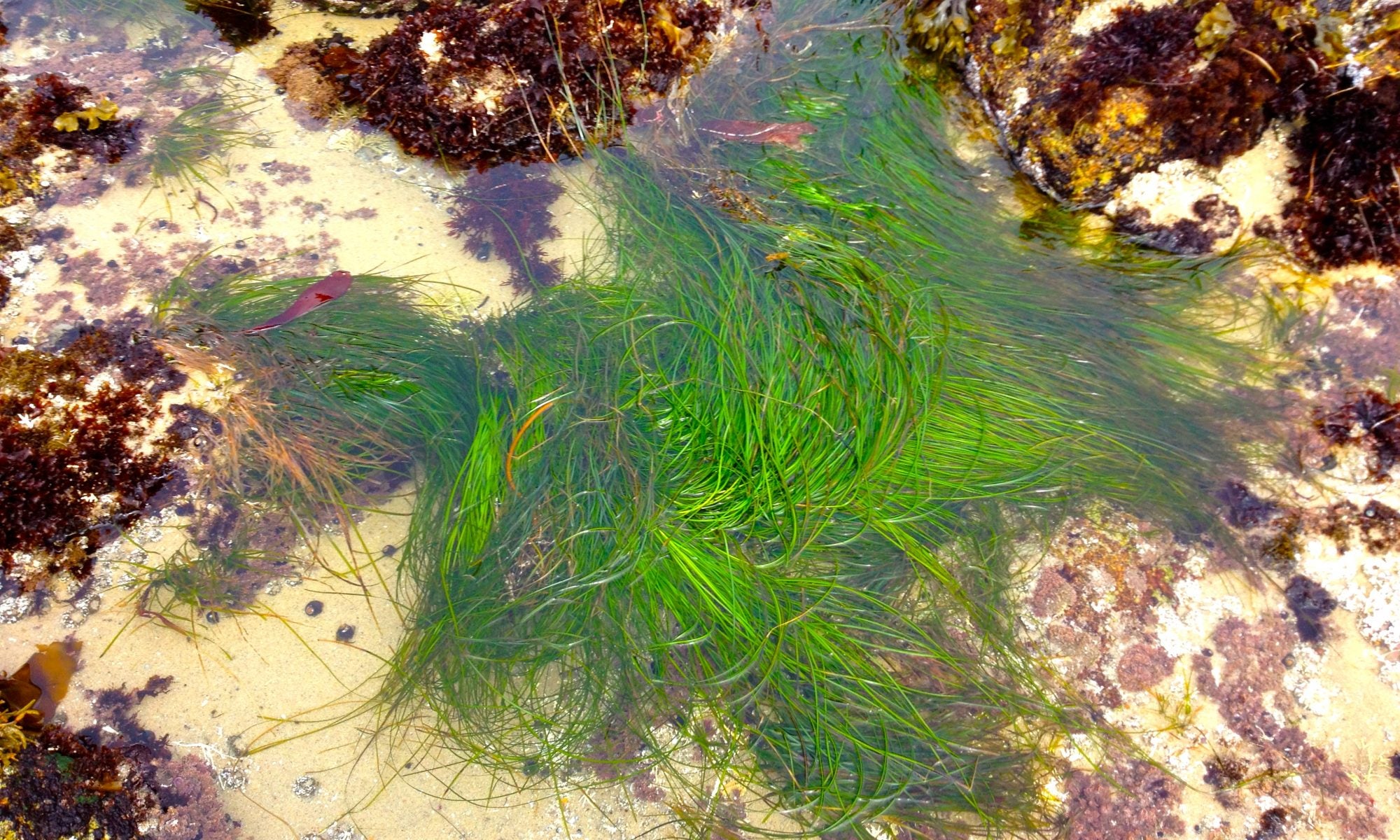Evolution and genetics of self/nonself recognition systems
Virtually all plants, fungi, and animals have self-nonself recognition systems that mediate the nature and outcomes of reproductive and somatic interactions between c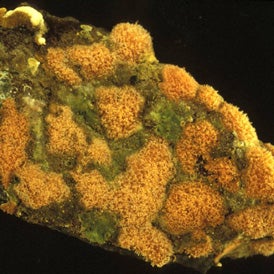 onspecifics. These allorecognition systems typically exhibit exceptional specificity, and presumably corresponding high levels of genetic polymorphism (i.e., allotypic diversity), sometimes exceeding by an order of magnitude levels of variation found at almost all other polymorphic loci.
onspecifics. These allorecognition systems typically exhibit exceptional specificity, and presumably corresponding high levels of genetic polymorphism (i.e., allotypic diversity), sometimes exceeding by an order of magnitude levels of variation found at almost all other polymorphic loci.
A major theme of my research over the last decade concerns identification of the selecti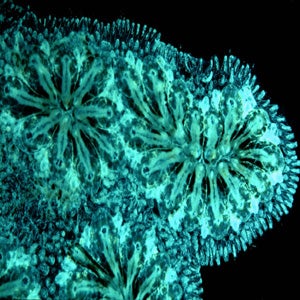 ve forces, including the control of fusion and inbreeding, that maintain this variation. Contrary to findings in some vertebrates, our recent work on the sea squirt Botryllus schlosseri and the hydroid Hydractinia symbiolongicarpus, suggests that evolution of extraordinary allorecognition polymorphism can occur in the absence of any detectable effect on the mating system. Instead, the regulation of fusion and aggression appear to predominate.
ve forces, including the control of fusion and inbreeding, that maintain this variation. Contrary to findings in some vertebrates, our recent work on the sea squirt Botryllus schlosseri and the hydroid Hydractinia symbiolongicarpus, suggests that evolution of extraordinary allorecognition polymorphism can occur in the absence of any detectable effect on the mating system. Instead, the regulation of fusion and aggression appear to predominate.
Causes of genetic structure and the implications of genetic structure for the evolution of social behavior, local adaptation, and speciation
The degree of correspondence between patterns of gene flow and the spatial scale over which selection varies provides the basic microevolutionary
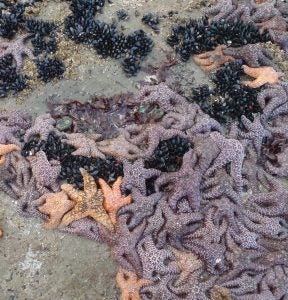
framework for interpreting patterns of phenotypic variation in any adaptively significant trait. In the case of traits such as mating and allorecognition systems, the genetic structure of a population itself – because it determines the relatedness of interactors – constitutes one of the most important elements of the selective regime.
My research continues to emphasize the analysis of genetic structure in natural populations, the effects of larval dispersal and behavior on structure, and how genetic structure relates to patterns of selection and the evolution of social behavior (e.g., Eppley et al. 1998; Hart and Grosberg 1999; Grosberg and Cunningham 2001).
Evolution of parental care and sibling cannibalism
My interests in the resolution of evolutionary conflict have recently led me to study parental care and sibling cannibalism in marine whelks. Many female whelks lay on hard surfaces egg cases that house developing larvae. Where rocks and algae are in short supply, whelks will sometimes lay eggs on each other.
Several years ago, we re-discovered a previously undocumented pattern of oviposition in a whelk (Solenosteira macrospira) from the Gulf of California: only males carry egg cases. This pattern of parental care is reminiscent of several other well-documented cases of male parental care in organisms such as giant water bugs. But what sets the scenario in Solenosteira apart from all other cases in which there is exclusive male care of offspring is that Solenosteira males have no obvious way of ensuring paternity, despite ample morphological (although not genetic) evidence from other whelks that females can store sperm. Thus, there is the potential for substantial conflict between males and females: from a female’s perspective, it appears that any living male provides a suitable oviposition site, whereas a male should not care for offspring sired by another male, particularly if he cannot ensure that he garners a mating in exchange.
is reminiscent of several other well-documented cases of male parental care in organisms such as giant water bugs. But what sets the scenario in Solenosteira apart from all other cases in which there is exclusive male care of offspring is that Solenosteira males have no obvious way of ensuring paternity, despite ample morphological (although not genetic) evidence from other whelks that females can store sperm. Thus, there is the potential for substantial conflict between males and females: from a female’s perspective, it appears that any living male provides a suitable oviposition site, whereas a male should not care for offspring sired by another male, particularly if he cannot ensure that he garners a mating in exchange.
Ecology and evolution of intraspecific aggression in clonal organisms
Many species of colonial marine invertebrates exhibit dramatic intraspecific variation in patterns of expression of allorecognition-dependent behaviors such as fusion and aggression. Several years ago, David Ayre and I began to explore the processes that maintain this variation in the clonal sea anemone Anthopleura elegantissima.
The paradigm for how cnidarians resolve intergenotypic conflicts over habitable space comes from studies of agonistic behavior in 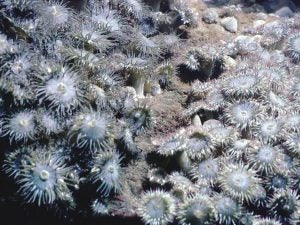 Anthopleura elegantissima. A. elegantissima clones consist of variable numbers of aggregated, asexually produced polyps. As clones expand and contact other conspecific clones, interacting polyps deploy specialized fighting tentacles (acrorhagi), and protracted battles ensue. This can lead either to the elimination of one clone, or to the formation of distinctive interclonal borders. Along these borders, the polyps sometimes differentiate into well-armed “warriors” that are smaller than the more central “reproductives”, and that lack gonads.
Anthopleura elegantissima. A. elegantissima clones consist of variable numbers of aggregated, asexually produced polyps. As clones expand and contact other conspecific clones, interacting polyps deploy specialized fighting tentacles (acrorhagi), and protracted battles ensue. This can lead either to the elimination of one clone, or to the formation of distinctive interclonal borders. Along these borders, the polyps sometimes differentiate into well-armed “warriors” that are smaller than the more central “reproductives”, and that lack gonads.
The long-standing dogma for Anthopleura was that individual genotypes were uniformly aggressive toward nonself, and passive toward clonemates. At least on a local scale, space should be dominated by single clones, and especially those which are most aggressive.
Our population genetic studies tell a very different story: even on very fine 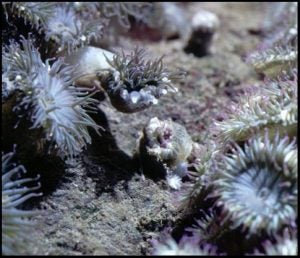 spatial scales (say, centimeters), clonal diversity is high. Moreover, Dave Ayre and I showed that at the level of individual polyps nearly all clones differ with respect to aggressiveness, tolerance, enhancement, and highly specific, inducible memory (Ayre & Grosberg 1995, 1996). One of the most surprising outcomes of these studies was that even members of clones that shared an interclonal border, which we assumed would be equally good fighters, were rarely evenly matched. This suggested that the pairwise contests individual pairs of polyps that we used to assess fighting ability did not reflect the fighting abilities of entire clones.
spatial scales (say, centimeters), clonal diversity is high. Moreover, Dave Ayre and I showed that at the level of individual polyps nearly all clones differ with respect to aggressiveness, tolerance, enhancement, and highly specific, inducible memory (Ayre & Grosberg 1995, 1996). One of the most surprising outcomes of these studies was that even members of clones that shared an interclonal border, which we assumed would be equally good fighters, were rarely evenly matched. This suggested that the pairwise contests individual pairs of polyps that we used to assess fighting ability did not reflect the fighting abilities of entire clones.
These observations raise three important questions related to the maintenance of behavioral polymorphism in this, and other, species. First, do clones differ in their patterns of allocation to warrior versus reproductive individuals (i.e., social organization)? Second, to what extent does interclonal variation in social organization reflect phenotypically plastic responses to variation in the social environment (e.g., the size, genotype, and behavior of neighboring clones) versus underlying genetic variation? Third, how stable are interclonal boundaries?
